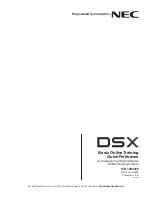
SECTION III.
PREPARATION
A. Major System Components
The following components comprise the R.O.
Drinking Water System. (Refer to Fig. 1, page 1 for
general system layout.)
1. An R.O. Manifold assembly.
2. Housings and Housing O–rings.
3. A Drinking Water Holding Tank.
4. A Dispensing Faucet.
5. A Feed Water Saddle Valve.
6. A Drain Clamp.
7. Plastic Tubing and tube connectors.
8. A Reverse Osmosis Membrane sealed in a
plastic bag.
9. A Sediment/Carbon Prefilter, shrink wrapped.
10. An Activated Carbon Post Filter, shrink
wrapped.
11. R.O. System Cover with or without optional
Water Quality Monitor.*
12. Nitrate/Nitrite Test Kit.
13. Water Quality Test Kit for systems without the
Water Quality Monitor.
14. Other items necessary for installation may
include wood screws or machine screws and
nuts for mounting the manifold, or concrete
anchors for hanging on basement wall, addi-
tional tubing or tube connectors, plastic wire
ties for organizing tubing.
* The Water Quality Monitor may be necessary to
conform to state or local codes, check with the local
plumbing authority.
B. Tools Recommended for Installation
The following tools will cover most of the installa-
tion sites encountered:
1.
3
/
8
" variable speed electric drill.
2. Extension work light with outlet.
3. Safety glasses.
4. 1 " porcelain hole cutter kit.
5. 1 " Greenlee hole punch and
1
/
8
" and
"
metal drill bits for pilot hole.
6. Center punch and hammer.
7. 1 " wood bit.
8. Concrete drill bits.
9. Assorted wood and metal drill bits including
7
/
32
" metal drill bit.
10. Phillips head and flat blade screwdrivers.
11. ",
9
/
16
" and
5
/
8
" open end wrenches.
12. 10" Crescent wrench with jaws taped to hold
faucet.
13. Basin wrench or 10" pipe wrench.
14. Teflon tape.
15. Wide masking tape or duct tape.
16. Plastic tubing cutter.
17. Extra plastic tubing.
18. Low range air pressure gauge.
19. Bicycle hand air pump.
20. Small bottle of liquid chlorine bleach.
21. Graduated measuring cylinder.
22. Paper towels, wisk broom and assorted clean
up materials.
C. Site Selection for Major System Components
The R.O. System was designed to fit under a sink,
however, because of space limitations or other rea-
sons, the system’s flexible design allows for other
locations. When determining the location remem-
ber that access to a cold water tap line, the house-
hold drain, and ease of filter replacement are
important considerations.
All components and tubing should be located in an
area which is not exposed to freezing tempera-
tures. If winter temperatures are severe, the area
should be above the minimum temperature listed
in Table B, page 3 for proper performance. Do not
expose unit or tubing to direct sunlight.
1. Dispensing Faucet
–
The faucet should be
placed near the sink where drinking water is
normally obtained. Convenience of use (filling
of water pitchers and glasses), and an open
area beneath the faucet under the sink for
attaching product and drain tubing are consid-
erations. A 2" diameter flat surface is required
above and below the installation site. The thick-
ness of the mounting surface should not
exceed 1 ". Watch for strengthening webbing
on the underside of cast iron sinks.
2. Drinking Water Holding Tank
–
The Holding
Tank may be placed where it is convenient
within 10 feet of the faucet; under the sink or in
an adjacent cabinet are the best choices. If a
longer run of tubing is required, the tubing
should be the
3
/
8
" diameter OD size to prevent






































